Conceptual Analog for Evaluating Empirically and Explicitly the Evolving Shear Stress Along Active Rockslide Planes Using the Complete Stress–Displacement Surface Model
Abstract
1. Introduction
2. Numerical Methods
2.1. Updated Complete Shear Stress–Displacement Surface Model
2.2. Complementary Empirical Relationships
2.3. Planar Failure Analytical Framework
3. Experimental Setting
4. Empirical Integration Method
5. Experimental Calibration Approach
5.1. Experimental Analog
5.2. Applied Calibration
6. Discussion
7. Conclusions
Author Contributions
Funding
Data Availability Statement
Acknowledgments
Conflicts of Interest
Appendix A
| Zone No. | Date | (MPa) | (MPa) | (mm) | (MPa) | (mm) | a | b | c | d | e |
|---|---|---|---|---|---|---|---|---|---|---|---|
| Zone I | 19-06-97 | 3.11 | 1.52 | 0.478 | 1.42 | 4.78 | 1.42 | 0.16 | 1.05 | 1.58 | 8.23 |
| 24-02-98 | 2.89 | 1.41 | 0.475 | 1.32 | 4.75 | 1.32 | 2.23 | 1.05 | 3.54 | 4.49 | |
| 01-11-98 | 1.75 | 0.85 | 0.453 | 0.80 | 4.53 | 0.80 | 1.65 | 1.10 | 2.45 | 4.50 | |
| 09-07-99 | 1.99 | 0.97 | 0.459 | 0.91 | 4.59 | 0.91 | 1.78 | 1.09 | 2.68 | 4.50 | |
| 15-03-00 | 2.03 | 0.99 | 0.460 | 0.92 | 4.60 | 0.92 | 1.79 | 1.09 | 2.72 | 4.50 | |
| 20-11-00 | 1.82 | 0.89 | 0.455 | 0.83 | 4.55 | 0.83 | 1.68 | 1.10 | 2.51 | 4.50 | |
| Zone II | 19-06-97 | 2.03 | 0.99 | 0.459 | 0.93 | 4.60 | 0.93 | 0.11 | 1.01 | 1.03 | 8.52 |
| 24-02-98 | 1.87 | 0.91 | 0.456 | 0.85 | 4.56 | 0.85 | 0.10 | 1.10 | 0.95 | 8.50 | |
| 01-11-98 | 1.22 | 0.60 | 0.438 | 0.55 | 4.38 | 0.55 | 0.06 | 1.14 | 0.62 | 8.89 | |
| 09-07-99 | 1.35 | 0.66 | 0.442 | 0.61 | 4.42 | 0.61 | 0.07 | 1.13 | 0.69 | 8.82 | |
| 15-03-00 | 1.37 | 0.67 | 0.443 | 0.62 | 4.43 | 0.62 | 0.07 | 1.13 | 0.69 | 8.81 | |
| 20-11-00 | 1.26 | 0.61 | 0.439 | 0.57 | 4.39 | 0.57 | 0.07 | 1.14 | 0.64 | 8.87 | |
| Zone III | 19-06-97 | 1.69 | 0.83 | 0.452 | 0.77 | 4.52 | 0.77 | 0.09 | 1.11 | 0.86 | 8.66 |
| 24-02-98 | 1.55 | 0.76 | 0.448 | 0.71 | 4.48 | 0.71 | 0.09 | 1.12 | 0.79 | 8.72 | |
| 01-11-98 | 1.04 | 0.51 | 0.432 | 0.47 | 4.32 | 0.47 | 0.05 | 1.16 | 0.53 | 9.01 | |
| 09-07-99 | 1.14 | 0.55 | 0.435 | 0.52 | 4.35 | 0.52 | 0.06 | 1.15 | 0.58 | 8.95 | |
| 15-03-00 | 1.15 | 0.56 | 0.436 | 0.52 | 4.36 | 0.52 | 0.06 | 1.15 | 0.58 | 8.94 | |
| 20-11-00 | 1.06 | 0.52 | 0.433 | 0.52 | 4.33 | 0.49 | 0.06 | 1.16 | 0.54 | 8.99 |
| (MPa) | (MPa) | (mm) | (MPa) | (mm) | |||||
|---|---|---|---|---|---|---|---|---|---|
| 1 | 1.59 | 0.15 | 0.71 | 3.87 | 0.71 | 1.07 | 1.3 | 1.78 | 16.56 |
| 2 | 2.44 | 0.31 | 1.44 | 6.28 | 1.44 | 1.28 | 0.79 | 2.83 | 8.69 |
| 5 | 4.85 | 0.35 | 3.03 | 6.41 | 3.03 | 2.40 | 0.78 | 5.43 | 7.71 |
| 10 | 9.9 | 0.25 | 6.64 | 8.2 | 6.64 | 3.79 | 0.61 | 10.43 | 13.37 |
| Zone No. | Date | (MPa) | (MPa) | (mm) | (MPa) | a | b | c | d | e | |
|---|---|---|---|---|---|---|---|---|---|---|---|
| Zone I | 19-06-97 | 3.11 | 3.4 | 0.44 | 2.10 | 8.8 | 2.11 | 1.67 | 0.57 | 3.78 | 6.58 |
| 24-02-98 | 2.89 | 3.2 | 0.44 | 1.96 | 8.7 | 1.96 | 1.58 | 0.57 | 3.54 | 6.61 | |
| 1-11-98 | 1.75 | 2.15 | 0.41 | 1.22 | 8.1 | 1.22 | 1.22 | 0.62 | 2.45 | 6.74 | |
| 09-07-99 | 1.99 | 2.38 | 0.41 | 1.38 | 8.3 | 1.38 | 1.30 | 0.60 | 2.68 | 6.70 | |
| 15-03-00 | 2.03 | 2.41 | 0.42 | 1.40 | 8.3 | 1.41 | 1.31 | 0.60 | 2.72 | 6.69 | |
| 20-11-00 | 1.82 | 2.22 | 0.41 | 1.27 | 8.2 | 1.27 | 1.25 | 0.61 | 2.51 | 6.73 | |
| Zone II | 19-06-97 | 2.03 | 2.41 | 0.42 | 1.41 | 8.3 | 1.41 | 1.29 | 0.60 | 2.70 | 6.71 |
| 24-02-98 | 1.87 | 2.27 | 0.41 | 1.31 | 8.2 | 1.31 | 1.24 | 0.61 | 2.54 | 6.74 | |
| 1-11-98 | 1.22 | 1.66 | 0.38 | 0.88 | 7.6 | 0.88 | 1.00 | 0.65 | 1.90 | 6.92 | |
| 09-07-99 | 1.35 | 1.79 | 0.39 | 0.96 | 7.8 | 0.96 | 1.06 | 0.64 | 2.02 | 6.87 | |
| 15-03-00 | 1.37 | 1.80 | 0.39 | 0.97 | 7.8 | 0.97 | 1.06 | 0.64 | 2.04 | 6.87 | |
| 20-11-00 | 1.26 | 1.70 | 0.38 | 0.91 | 7.7 | 0.91 | 1.02 | 0.65 | 1.93 | 6.90 | |
| Zone III | 19-06-97 | 1.69 | 2.10 | 0.40 | 1.20 | 8.1 | 1.19 | 1.18 | 0.62 | 2.37 | 6.80 |
| 24-02-98 | 1.55 | 1.97 | 0.40 | 1.10 | 8.0 | 1.10 | 1.13 | 0.63 | 2.22 | 6.80 | |
| 1-11-98 | 1.04 | 1.50 | 0.37 | 0.80 | 7.4 | 0.80 | 0.95 | 0.67 | 1.71 | 7.00 | |
| 09-07-99 | 1.14 | 1.59 | 0.38 | 0.82 | 7.5 | 0.80 | 0.98 | 0.66 | 1.81 | 6.90 | |
| 15-03-00 | 1.15 | 1.60 | 0.38 | 0.83 | 7.6 | 0.83 | 0.98 | 0.66 | 1.82 | 6.95 | |
| 20-11-00 | 1.06 | 1.52 | 0.37 | 0.78 | 7.5 | 0.78 | 0.96 | 0.67 | 1.74 | 6.90 |
References
- Donati, D.; Stead, D.; Borgatti, L. The Importance of Rock Mass Damage in the Kinematics of Landslides. Geosciences 2023, 13, 52. [Google Scholar] [CrossRef]
- Deng, D.; Simon, R.; Aubertin, M. Modelling shear and normal behaviour of filled rock joints. In GeoCongress 2006: Geotechnical Engineering in the Information Technology Age; ASCE: Reston, VA, USA, 2006; pp. 1–6. [Google Scholar]
- Wyllie, D.C.; Mah, C. Rock Slope Engineering: Civil End Mining; CRC Press: London, UK, 2004. [Google Scholar]
- Fukuzono, T. A new method for predicting the failure time of a slope. In Proceedings of the 4th International Conference and Field Workshop on Landslide, Tokyo, Japan, 23ߝ31 August 1985; pp. 145–150. [Google Scholar]
- Crosta, G.B.; Agliardi, F. Failure forecast for large rock slides by surface displacement measurements. Can. Geotech. J. 2003, 40, 176–191. [Google Scholar]
- Rose, N.D.; Hungr, O. Forecasting potential rock slope failure in open pit mines using the inverse-velocity method. Int. J. Rock Mech. Min. Sci. 2007, 44, 308–320. [Google Scholar] [CrossRef]
- Kodama, J.; Nishiyama, E.; Kaneko, K. Measurement and interpretation of long-term deformation of a rock slope at the Ikura limestone quarry, Japan. Int. J. Rock Mech. Min. Sci. 2009, 46, 148–158. [Google Scholar] [CrossRef]
- Oppikofer, T.; Jaboyedoff, M.; Blikra, L.; Derron, M.H.; Metzger, R. Characterization and monitoring of the Åknes rockslide using terrestrial laser scanning. Nat. Hazards Earth Syst. Sci. 2009, 9, 1003–1019. [Google Scholar]
- Basahel, H.; Mitri, H. Application of rock mass classification systems to rock slope stability assessment: A case study. J. Rock Mech. Geotech. Eng. 2017, 9, 993–1009. [Google Scholar]
- Storni, E.; Hugentobler, M.; Manconi, A.; Loew, S. Monitoring and analysis of active rockslide-glacier interactions (Moosfluh, Switzerland). Geomorphology 2020, 371, 107414. [Google Scholar] [CrossRef]
- Vibert, C.; Arnould, M.; Cojean, R.; Le Cleach, J.M. Essai de prévision de rupture d’un versant montagneux à Saint-Etienne-de-Tinée. In Proceedings of the Fifth International Symposium on Landslides, Lausanne, Switzerland, 10ߝ15 July 1988; pp. 789–792. [Google Scholar]
- Sharon, R.; Rose, N.; Rantapaa, M. Design and development of the Northeast layback of the Betze-post open pit. In Proceeding of the SME Annual Meeting, Salt Lake City, UT, USA, 28 February–2 March 2005; pp. 05–09. [Google Scholar]
- Patton, F.D. Multiple Modes of Shear Failure in Rock and Related Materials. Ph.D. Thesis, University of Illinois at Urbana-Champaign, Champaign, IL, USA, 1966. [Google Scholar]
- Ladanyi, B.; Archambault, G. Simulation of shear behavior of a jointed rock mass. In Proceedings of the 11th US Symposium on Rock Mechanics (USRMS), Berkeley, CA, USA, 16–19 June 1969. OnePetro. [Google Scholar]
- Barton, N.; Choubey, V. The shear strength of rock joints in theory and practice. Rock Mech. 1977, 10, 1–54. [Google Scholar]
- Bandis, S.; Lumsden, A.C.; Barton, N.R. Experimental studies of scale effects on the shear behaviour of rock joints. Int. J. Rock Mech. Min. Sci. Geomech. Abstr. 1981, 18, 1–21. [Google Scholar]
- Barton, N. Modelling Rock Joint Behavior from In Situ Block Tests: Implications for Nuclear Waste Repository Design; Office of Nuclear Waste Isolation, Battelle Project Management Division: Columbus, OH, USA, 1982; Volume 308. [Google Scholar]
- Grasselli, G.; Egger, P. Constitutive law for the shear strength of rock joints based on three-dimensional surface parameters. Int. J. Rock Mech. Min. Sci. 2003, 40, 25–40. [Google Scholar]
- Barton, N.; Bandis, S.; Bakhtar, K. Strength, deformation and conductivity coupling of rock joints. Int. J. Rock Mech. Min. Sci. Geomech. Abstr. 1985, 22, 121–140. [Google Scholar] [CrossRef]
- Xie, S.; Lin, H.; Han, Z.; Duan, H.; Chen, Y.; Li, D. A New Shear Constitutive Model Characterized by the Pre-Peak Nonlinear Stage. Minerals 2022, 12, 1429. [Google Scholar] [CrossRef]
- Lin, H.; Xie, S.; Yong, R.; Chen, Y.; Du, S. An empirical statistical constitutive relationship for rock joint shearing considering scale effect. Comptes Rendus. Mécanique 2019, 347, 561–575. [Google Scholar] [CrossRef]
- Cheng, T.; Guo, B.H.; Sun, J.H.; Tian, S.X.; Sun, C.X.; Chen, Y. Establishment of constitutive relation of shear deformation for irregular joints in sandstone. Rock Soil Mech. 2022, 43, 4. [Google Scholar]
- Simon, R. Analysis of Fault-Slip Mechanisms in Hard Rock Mining. Ph.D. Thesis, McGill University, Montreal, QC, Canada, 1999. [Google Scholar]
- Simon, R.; Aubertin, M.; Deng, D. Estimation of post-peak behaviour of brittle rocks using a constitutive model for rock joints. In Proceedings of the 56th Canadian Geotechnical Conference, Winnipeg, MB, Canada, 29 September–1 October 2003. [Google Scholar]
- Tremblay, D.; Simon, R.; Aubertin, M. A constitutive model to predict the hydromechanical behavior of rock joints. In Proceedings of the GeoOttawa, Ottawa, ON, Canada, 21–24 October 2007; pp. 2011–2018. [Google Scholar]
- Deiminiat, A.; Aubertin, J.D.; Ethier, Y. On the calibration of a shear stress criterion for rock joints to represent the full stress-strain profile. J. Rock Mech. Geotech. Eng. 2024, 16, 379–392. [Google Scholar] [CrossRef]
- Asadollahi, P. Stability Analysis of a Single Three-Dimensional Rock Block: Effect of Dilatancy and High-Velocity Water Jet Impact. Ph.D. Thesis, The University of Texas at Austin, Austin, TX, USA, 2009. [Google Scholar]
- Asadollahi, P.; Tonon, F. Constitutive model for rock fractures: Revisiting Barton’s empirical model. Eng. Geol. 2010, 113, 11–32. [Google Scholar] [CrossRef]
- Wang, M.; Cai, M. A simplified model for time-dependent deformation of rock joints. Rock Mech. Rock Eng. 2021, 54, 1779–1797. [Google Scholar] [CrossRef]
- Wang, M. Modeling Time-Dependent Deformation Behavior of Jointed Rock Mass. Ph.D. Thesis, Laurentian University of Sudbury, Greater Sudbury, ON, Canada, 2022. [Google Scholar]
- Hoek, E.; Bray, J.D. Rock Slope Engineering, 3rd ed.; Taylor and Francis Group: London, UK, 1981. [Google Scholar]
- Agliardi, F.; Crosta, G.; Zanchi, A. Structural constraints on deep-seated slope deformation kinematics. Eng. Geol. 2001, 59, 83–102. [Google Scholar] [CrossRef]
- Manconi, A.; Kourkouli, P.; Caduff, R.; Strozzi, T.; Loew, S. Monitoring surface deformation over a failing rock slope with the ESA sentinels: Insights from Moosfluh instability, Swiss Alps. Remote Sens. 2018, 10, 672. [Google Scholar] [CrossRef]
- Glueer, F.; Loew, S.; Manconi, A. Paraglacial history and structure of the Moosfluh Landslide (1850–2016), Switzerland. Geomorphology 2020, 355, 106677. [Google Scholar] [CrossRef]
- Zou, L.; Cvetkovic, V. A new approach for predicting direct shear tests on rock fractures. Int. J. Rock Mech. Min. Sci. 2023, 168, 105408. [Google Scholar]
- Jacobsson, L.; Ivars, D.M.; Kasani, H.A.; Johansson, F.; Lam, T. Experimental program on mechanical properties of large rock fractures. IOP Conf. Ser. Earth Environ. Sci. 2021, 833, 012015. [Google Scholar] [CrossRef]
- Fardin, N. Influence of structural non-stationarity of surface roughness on morphological characterization and mechanical deformation of rock joints. Rock Mech. Rock Eng. 2008, 41, 267–297. [Google Scholar]
- Tan, R.; Chai, J.; Cao, C. Experimental investigation of the permeability measurement of radial flow through a single rough fracture under shearing action. Adv. Civ. Eng. 2019, 1, 6717295. [Google Scholar]
- Deiminiat, A.; Li, L.; Zeng, F. Experimental study on the minimum required specimen width to maximum particle size ratio in direct shear tests. CivilEng 2022, 3, 66–84. [Google Scholar] [CrossRef]
- Deiminiat, A.; Li, L.; Zeng, F.; Pabst, T.; Chiasson, P.; Chapuis, R. Determination of the Shear Strength of Rockfill from Small-Scale Laboratory Shear Tests: A Critical Review. Adv. Civ. Eng. 2020, 1, 8890237. [Google Scholar] [CrossRef]
- Wang, G.; Zhang, X.; Jiang, Y.; Wu, X.; Wang, S. Rate-dependent mechanical behavior of rough rock joints. Int. J. Rock Mech. Min. Sci. 2016, 83, 231–240. [Google Scholar]
- Holtz, R.D.; Kovacs, W.D.; Sheahan, T.C. An Introduction to Geotechnical Engineering, 3rd ed.; Pearson: New York, NY, USA, 2022. [Google Scholar]
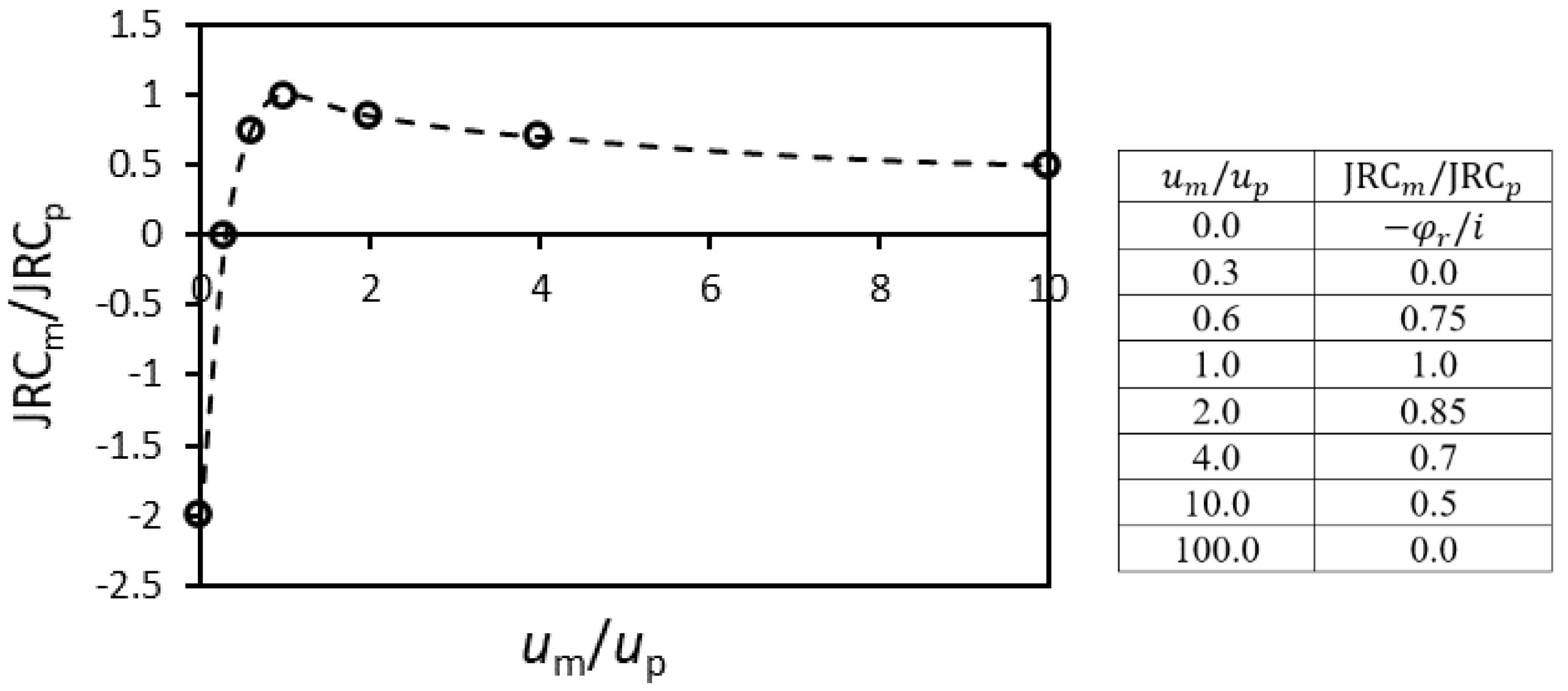
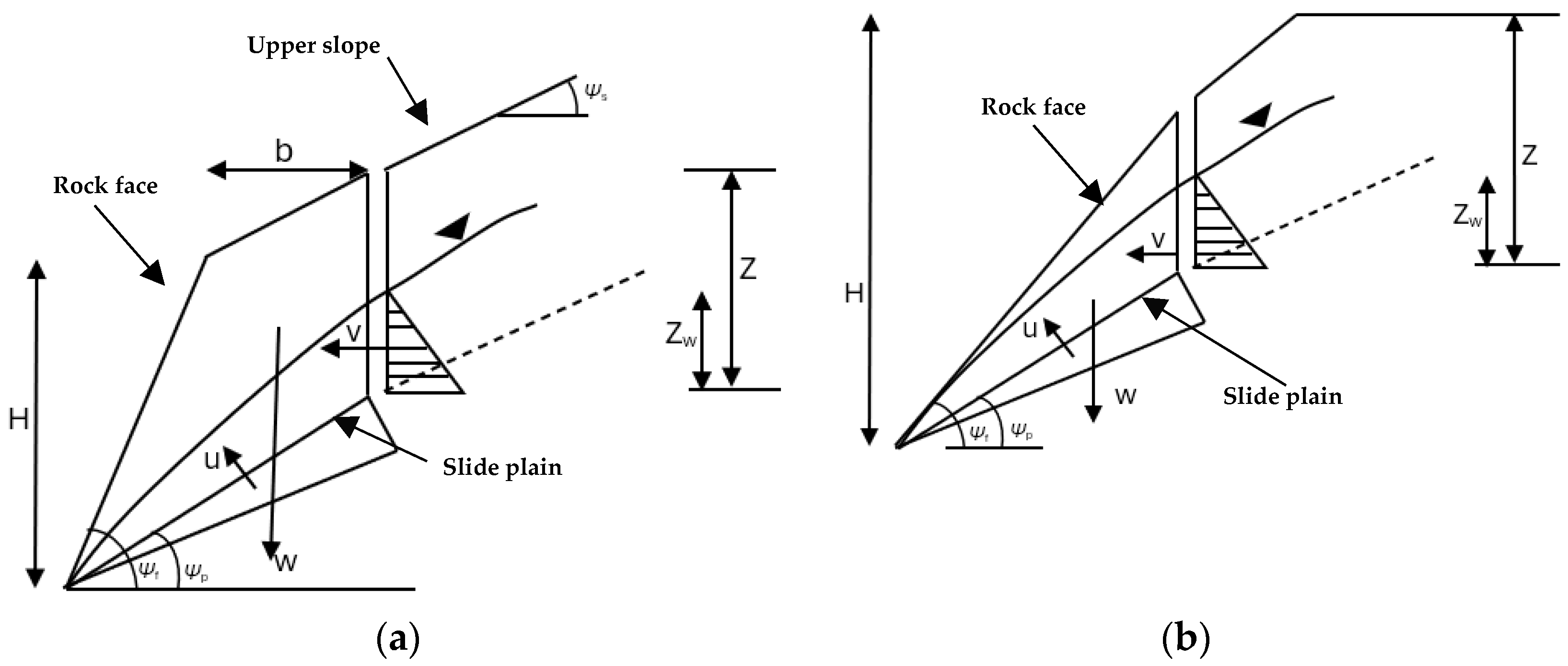
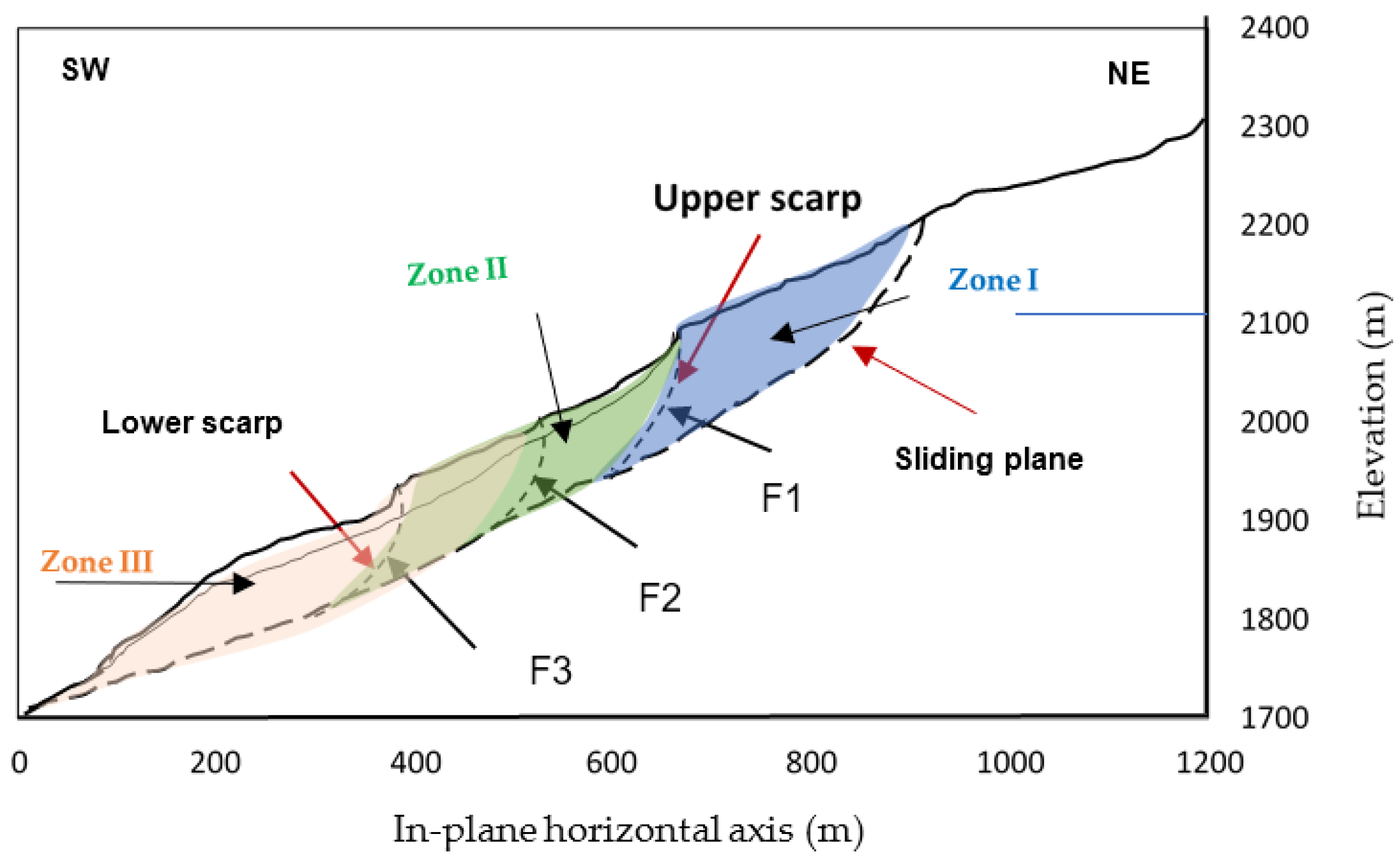
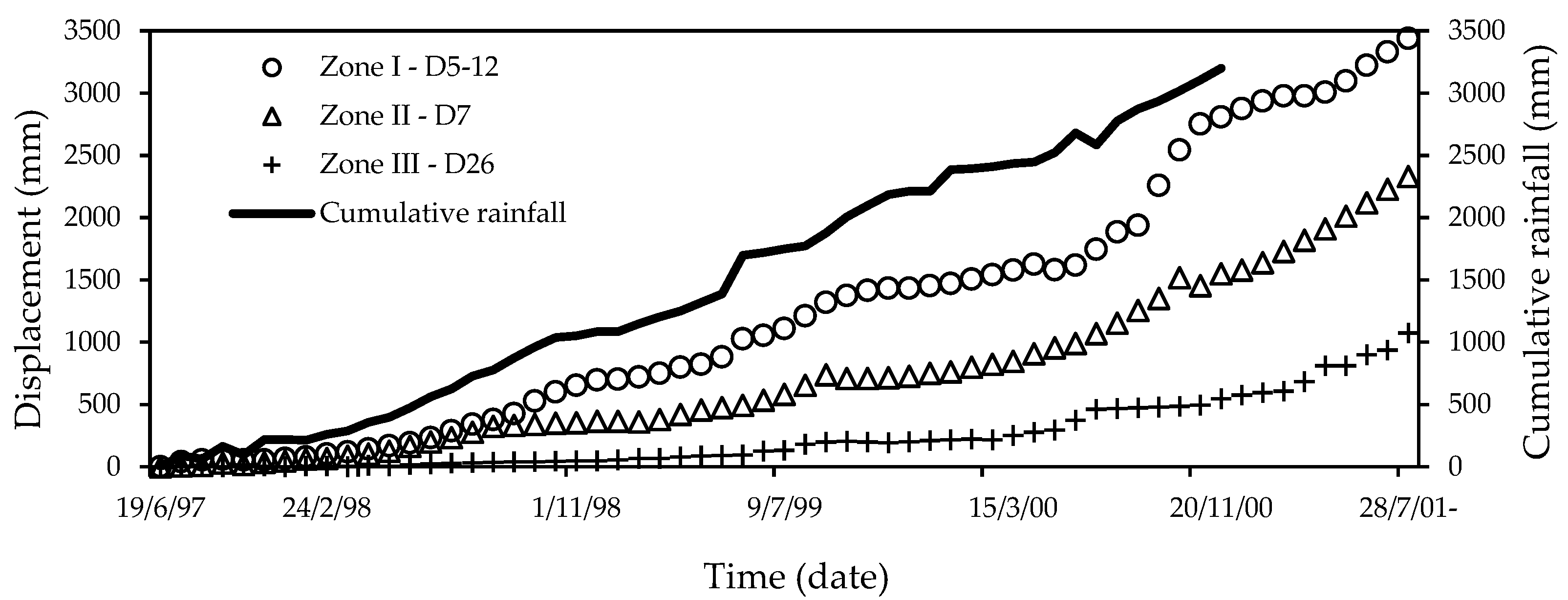

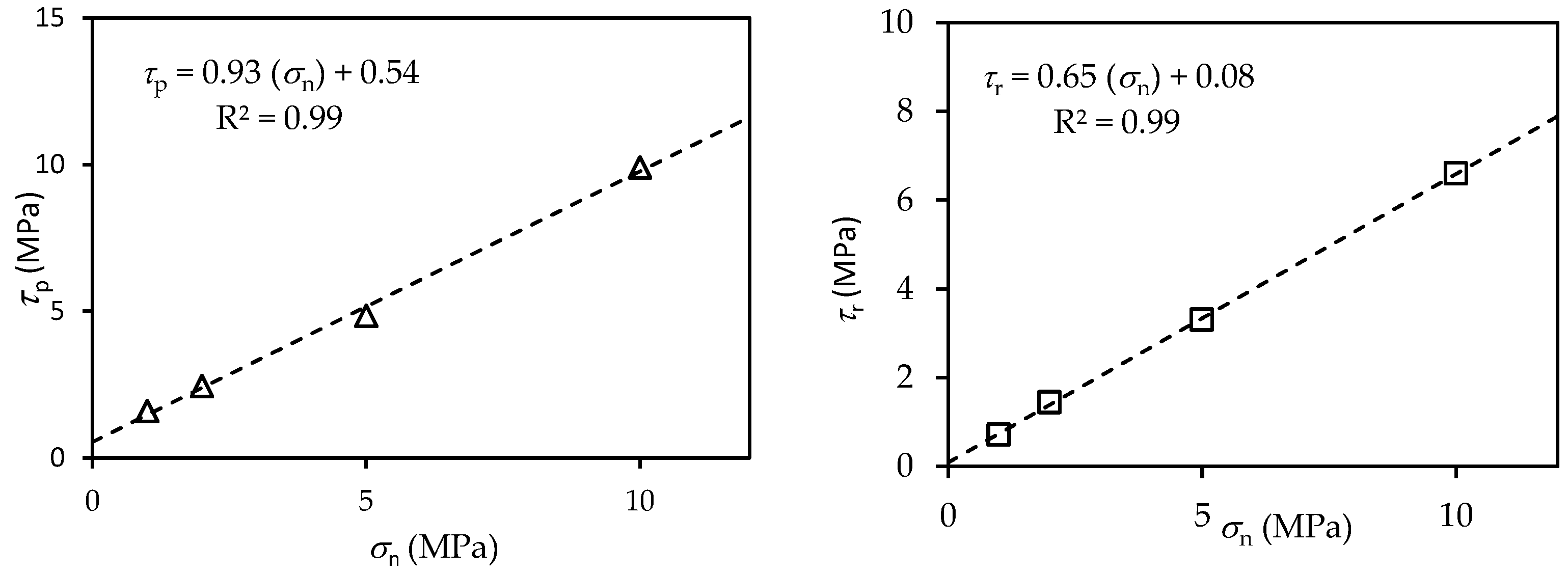
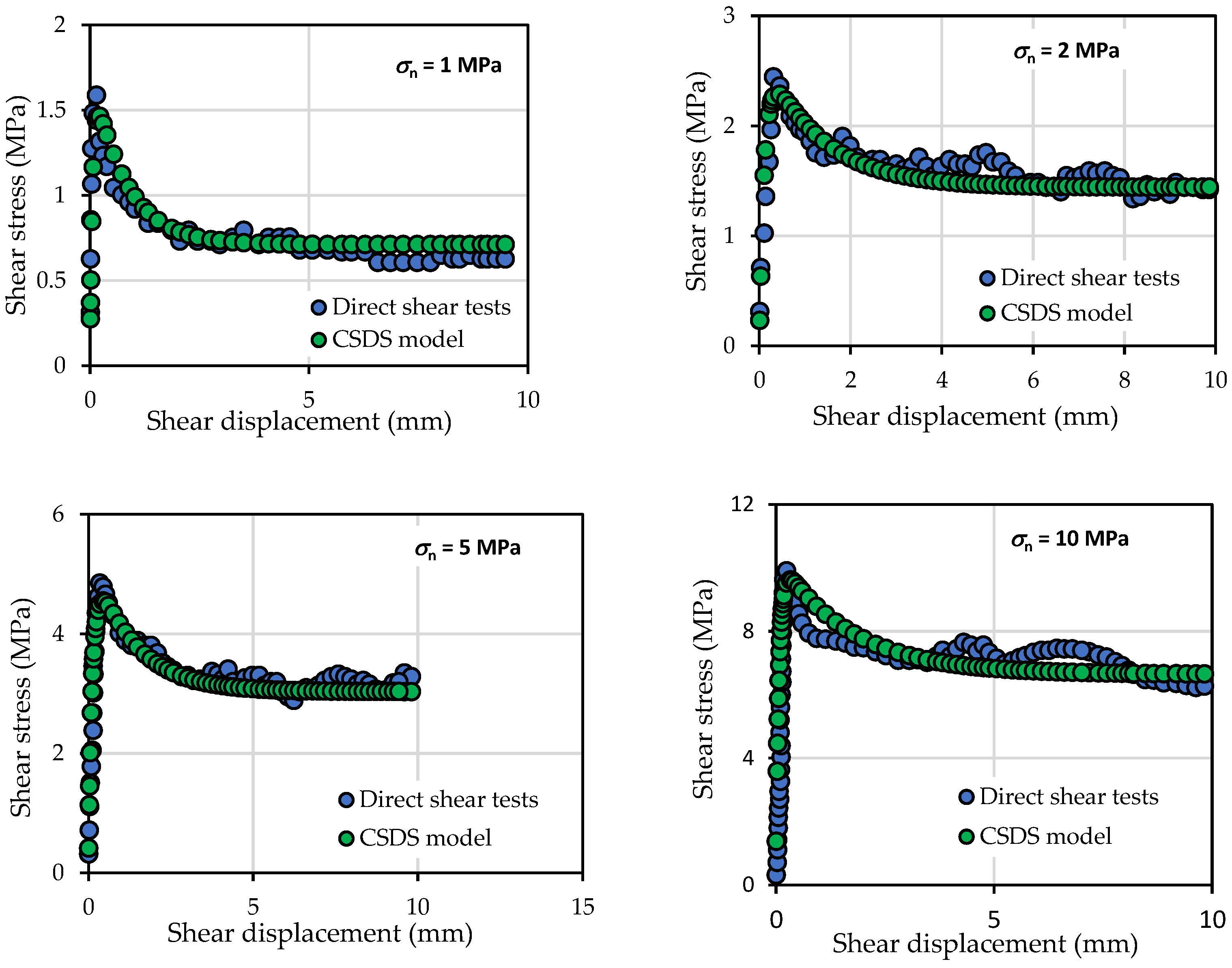
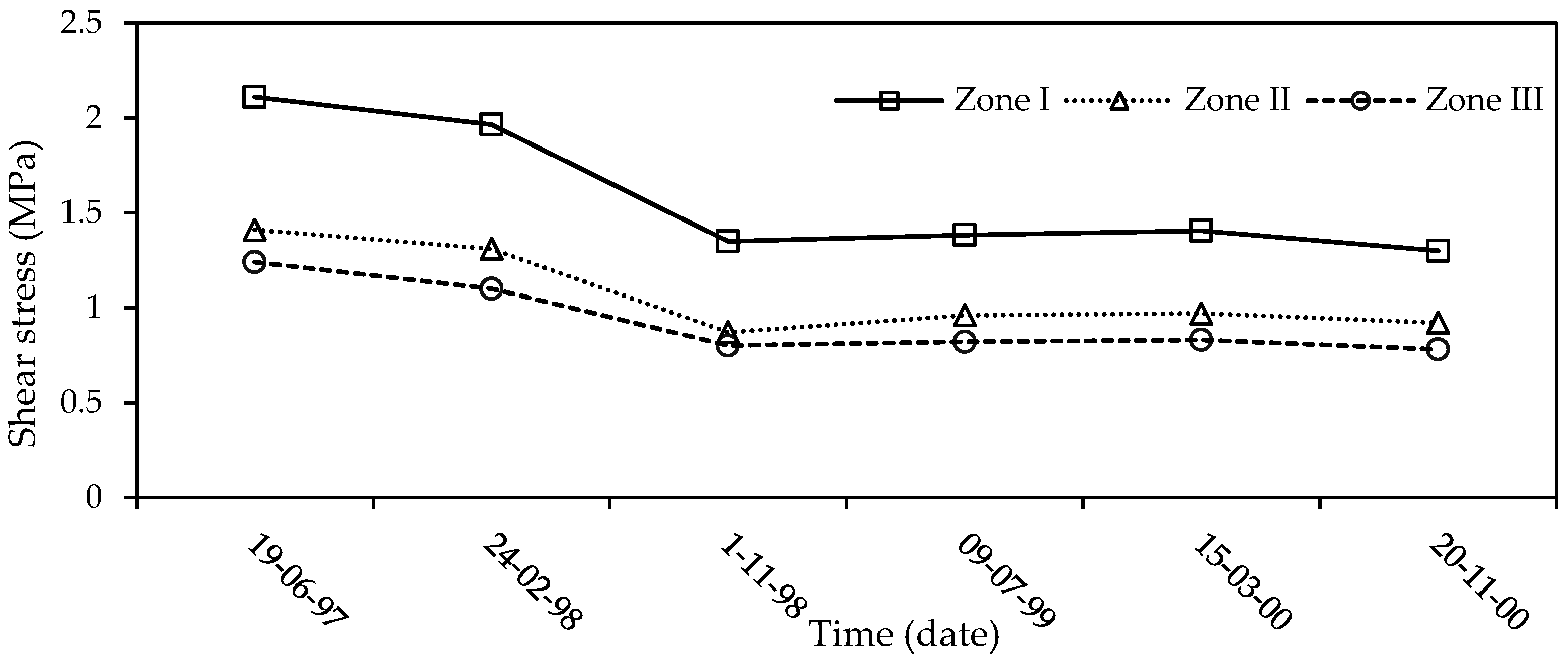
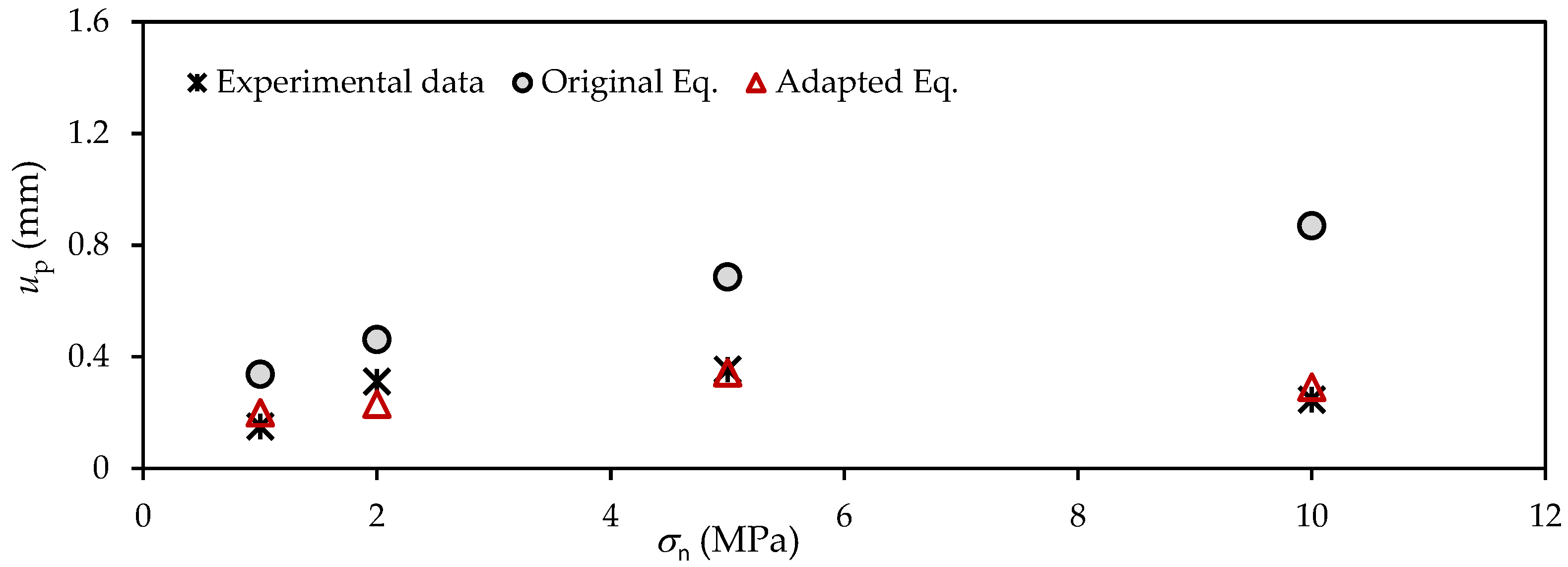
Axial strain on the pre-peak stress–strain curve σn, σc, and σ1 are the normal stress, uniaxial compressive strength, and main axial stress. up and ur are the peak displacement and residual displacement. ϕb and ϕr are the basic friction angle and residual friction angle. Vm, kni, aj, JRCp, JRCm, JCS, and L are the maximum closure, initial normal stiffness, initial joint aperture, peak joint roughness coefficient, mobilized joint roughness coefficient, joint compressive strength, and specimen length. ɛ, ɛprepeak, and β are the axial strain, pre-peak strain, and shear plane angle. |
(kN/m3) | (MPa) | (MPa) | JRC | JCS (MPa) | (°) | (°) |
|---|---|---|---|---|---|---|
| 26.7 | 73 | 12 | 9–14 | 11.8–28.4 | 26 | 24.5 |
| Rockslide Zones | (m) | (m) | (m) | (m2) | ψp (°) | ψf (°) | (kN/m) |
|---|---|---|---|---|---|---|---|
| Zone I | 125 | 140 | 99 | 70 | 34 | 64 | 274.3 |
| Zone II | 126 | 124 | 111 | 139 | 30 | 62 | 340.6 |
| Zone III | 124 | 123 | 127 | 219 | 21 | 41 | 415.2 |
| Zone No. | Date | Rainfall (mm) | (m) | (kN/m) | (kN/m) | (MPa) |
|---|---|---|---|---|---|---|
| Zone I | 19 Jun. 1997 | 89.3 | 15.6 | 5484.8 | 1221.4 | 3.11 |
| 24 Feb. 1998 | 261.2 | 46.3 | 16,092.9 | 10,514.8 | 2.89 | |
| 01 Nov. 1998 | 790.4 | 140.2 | 48,730.7 | 96,412.9 | 1.75 | |
| 09 Jul. 1999 | 698.5 | 123.9 | 43,065.2 | 75,297.7 | 1.99 | |
| 15 Mar. 2000 | 685.0 | 121.5 | 42,234.4 | 72,420.8 | 2.03 | |
| 20 Nov. 2000 | 765.1 | 135.7 | 47,166.6 | 90,323.1 | 1.82 | |
| 28. Jul. 2001 | NA | ----- | ----- | ------ | ----- | |
| Zone II | 19 Jun. 1997 | 89.3 | 14.05 | 9592.14 | 968.26 | 2.03 |
| 24 Feb. 1998 | 261.2 | 41.24 | 28,148.32 | 8338.07 | 1.87 | |
| 01 Nov. 1998 | 790.4 | 124.8 | 85,202.8 | 76,395.6 | 1.22 | |
| 09 Jul. 1999 | 698.5 | 110.3 | 75,303.4 | 59,674.7 | 1.35 | |
| 15 Mar. 2000 | 685.0 | 108.2 | 73,842.4 | 57,381.6 | 1.37 | |
| 20 Nov. 2000 | 765.1 | 120.1 | 81,980.4 | 70,726.2 | 1.26 | |
| 28. Jul. 2001 | NA | ----- | ----- | ------ | ----- | |
| Zone III | 19 Jun. 1997 | 89.3 | 13.9 | 14,889.8 | 940.9 | 1.69 |
| 24 Feb. 1998 | 261.2 | 40.6 | 43,960.9 | 8101.1 | 1.55 | |
| 01 Nov. 1998 | 790.4 | 123.0 | 132,234 | 74,207.7 | 1.04 | |
| 09 Jul. 1999 | 698.5 | 108.7 | 116,849.7 | 57,945.3 | 1.14 | |
| 15 Mar. 2000 | 685.0 | 106.6 | 114,602.8 | 55,738.3 | 1.15 | |
| 20 Nov. 2000 | 765.1 | 119.1 | 128,009 | 69,541.5 | 1.06 | |
| 28. Jul. 2001 | NA | ----- | ----- | ------ | ----- |
| Zone No. | Date | (MPa) | Displacement (mm) | Shear Stress (MPa) | JRCc-m | (MPa) | |
|---|---|---|---|---|---|---|---|
| Zone I | 19 Jun. 1997 | 3.11 | 18.135 | 1.42 | 0.78 | 0.97 | 1.43 |
| 24 Feb. 1998 | 2.89 | 60.449 | 1.32 | 0.76 | 0.97 | 1.34 | |
| 01 Nov. 1998 | 1.75 | 598.45 | 0.80 | 0.62 | 0.97 | 0.82 | |
| 09 Jul. 1999 | 1.99 | 822.11 | 0.91 | 0.65 | 0.97 | 0.93 | |
| 15 Mar. 2000 | 2.03 | 1426.6 | 0.92 | 0.65 | 0.97 | 0.95 | |
| 20 Nov. 2000 | 1.82 | 2133.9 | 0.83 | 0.63 | 0.97 | 0.85 | |
| Zone II | 28. Jul. 2001 | 2.03 | 12.007 | 0.93 | 0.65 | 0.97 | 0.96 |
| 19 Jun. 1997 | 1.87 | 66.038 | 0.85 | 0.63 | 0.97 | 0.88 | |
| 24 Feb. 1998 | 1.22 | 342.19 | 0.55 | 0.60 | 0.97 | 0.57 | |
| 01 Nov. 1998 | 1.35 | 468.27 | 0.62 | 0.60 | 0.97 | 0.64 | |
| 09 Jul. 1999 | 1.37 | 744.42 | 0.62 | 0.57 | 0.97 | 0.65 | |
| 15 Mar. 2000 | 1.26 | 1224.7 | 0.58 | 0.55 | 0.97 | 0.60 | |
| Zone III | 20 Nov. 2000 | 1.69 | 5.0000 | 0.78 | 0.61 | 0.97 | 0.85 |
| 28. Jul. 2001 | 1.55 | 10.000 | 0.71 | 0.59 | 0.97 | 0.76 | |
| 19 Jun. 1997 | 1.04 | 52.030 | 0.50 | 0.52 | 0.97 | 0.57 | |
| 24 Feb. 1998 | 1.14 | 95.050 | 0.52 | 0.54 | 0.97 | 0.55 | |
| 01 Nov. 1998 | 1.15 | 198.11 | 0.52 | 0.54 | 0.97 | 0.54 | |
| 09 Jul. 1999 | 1.06 | 372.21 | 0.49 | 0.53 | 0.97 | 0.53 |
| Young’s Modulus (GPa) | (MPa) | (°) |
|---|---|---|
| 73 | 255 | 22.2 |
| (MPa) | JRCc-m | (MPa) | |
|---|---|---|---|
| 1 | 8.87 | 0.64 | 1.02 |
| 2 | 8.12 | 0.69 | 1.70 |
| 5 | 6.0 | 0.76 | 3.66 |
| 10 | 5.6 | 0.75 | 7.43 |
| Zone No. | Date | (MPa) | Displacement (mm) | Shear Stress (MPa) | JRCc-m | (MPa) | |
|---|---|---|---|---|---|---|---|
| Zone I | 19-06-97 | 3.11 | 18.135 | 2.11 | 14.5 | 0.71 | 2.2 |
| 24-02-98 | 2.89 | 60.449 | 1.96 | 14.2 | 0.71 | 1.85 | |
| 01-11-98 | 1.75 | 598.45 | 1.40 | 13.1 | 0.69 | 1.38 | |
| 09-07-99 | 1.99 | 822.11 | 1.38 | 13.3 | 0.69 | 1.65 | |
| 15-03-00 | 2.03 | 1426.6 | 1.41 | 13.3 | 0.69 | 1.67 | |
| 20-11-00 | 1.82 | 2133.9 | 1.30 | 13.1 | 0.69 | 1.53 | |
| Zone II | 19-06-97 | 2.03 | 12.007 | 1.41 | 13.3 | 0.69 | 1.68 |
| 24-02-98 | 1.87 | 66.038 | 1.31 | 13.2 | 0.69 | 1.57 | |
| 01-11-98 | 1.22 | 342.19 | 0.87 | 12.8 | 0.67 | 1.12 | |
| 09-07-99 | 1.35 | 468.27 | 0.96 | 12.9 | 0.68 | 1.21 | |
| 15-03-00 | 1.37 | 744.42 | 0.97 | 12.9 | 0.68 | 1.22 | |
| 20-11-00 | 1.26 | 1224.7 | 0.92 | 12.9 | 0.67 | 1.15 | |
| Zone III | 19-06-97 | 1.69 | 5.0000 | 1.24 | 13.0 | 0.69 | 1.45 |
| 24-02-98 | 1.55 | 10.000 | 1.01 | 13.0 | 0.68 | 1.35 | |
| 01-11-98 | 1.04 | 52.030 | 0.80 | 12.8 | 0.67 | 1.00 | |
| 09-07-99 | 1.14 | 95.050 | 0.82 | 12.8 | 0.67 | 1.06 | |
| 15-03-00 | 1.15 | 198.11 | 0.83 | 12.8 | 0.67 | 1.07 | |
| 20-11-00 | 1.06 | 372.21 | 0.80 | 12.8 | 0.67 | 1.02 |
Disclaimer/Publisher’s Note: The statements, opinions and data contained in all publications are solely those of the individual author(s) and contributor(s) and not of MDPI and/or the editor(s). MDPI and/or the editor(s) disclaim responsibility for any injury to people or property resulting from any ideas, methods, instructions or products referred to in the content. |
© 2025 by the authors. Licensee MDPI, Basel, Switzerland. This article is an open access article distributed under the terms and conditions of the Creative Commons Attribution (CC BY) license (https://creativecommons.org/licenses/by/4.0/).
Share and Cite
Deiminiat, A.; Aubertin, J.D. Conceptual Analog for Evaluating Empirically and Explicitly the Evolving Shear Stress Along Active Rockslide Planes Using the Complete Stress–Displacement Surface Model. Geosciences 2025, 15, 139. https://doi.org/10.3390/geosciences15040139
Deiminiat A, Aubertin JD. Conceptual Analog for Evaluating Empirically and Explicitly the Evolving Shear Stress Along Active Rockslide Planes Using the Complete Stress–Displacement Surface Model. Geosciences. 2025; 15(4):139. https://doi.org/10.3390/geosciences15040139
Chicago/Turabian StyleDeiminiat, Akram, and Jonathan. D. Aubertin. 2025. "Conceptual Analog for Evaluating Empirically and Explicitly the Evolving Shear Stress Along Active Rockslide Planes Using the Complete Stress–Displacement Surface Model" Geosciences 15, no. 4: 139. https://doi.org/10.3390/geosciences15040139
APA StyleDeiminiat, A., & Aubertin, J. D. (2025). Conceptual Analog for Evaluating Empirically and Explicitly the Evolving Shear Stress Along Active Rockslide Planes Using the Complete Stress–Displacement Surface Model. Geosciences, 15(4), 139. https://doi.org/10.3390/geosciences15040139






